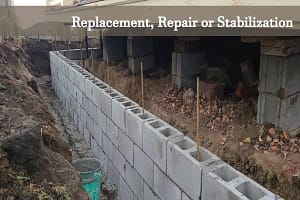The smart Trick of Best Basement Waterproofing That Nobody is Discussing
Wiki Article
A Biased View of Best Basement Waterproofing
Table of ContentsAll About Best Basement WaterproofingMore About Best Basement WaterproofingThe Ultimate Guide To Best Basement WaterproofingThe Best Strategy To Use For Best Basement WaterproofingBest Basement Waterproofing Fundamentals Explained
AdvantaClean's skilled experts and professionals will find the water resource. If wall or piece fractures are existing, we will certainly infuse polyurethane and epoxies into the splits and seal the concession, stopping additional wetness from getting in.Setting up cellar air flow systems, conditioning systems, or basement dehumidifier systems to get water out of your basement. Picking AdvantaClean's cellar waterproofing solutions is an efficient way to treat moisture and avoid mold and mildew from jeopardizing the framework of your home and the health and wellness of your family members.
If there's condensation on the exterior of the aluminum foil, you have high moisture in your basement. If the aluminum foil has condensation on the within surface area (next to the wall), the soil around your residence might be normally damp from a high water table or poor dirt drain.
You can waterproof simply your interior wall surfaces, which might fix the issue. Once they dry, they adhere permanently to concrete and masonry wall surfaces.
Best Basement Waterproofing Can Be Fun For Anyone
Concrete waterproof coverings can't be used to formerly painted surfaces; inspect the label. Recognized as densifiers, they are ideal only for wall surfaces that haven't been repainted or sealed.But you clean, roll, or spray it on a lot more heavily one gallon covers just 75 square feet, not the 300 square feet common with basic paint. Waterproof paint is fine for do it yourself application. You can apply it over repainted surfaces, and paint over it once it's healed (one gallon costs $37).
It can set you back $10,000 to $15,000, depending on the job required (Best Basement Waterproofing). Outside waterproofing involves excavating all around the residence to the full deepness of the foundation walls, after that setting up a waterproof coating or membrane topped by drain panels.
Best Basement Waterproofing Can Be Fun For Everyone
A cellar without waterproofing is kind of like that. Your cellar doesn't desire to go with a rainstorm without proper defense just as much as you don't desire to.
Outside waterproofing is a waterproofing technique that entails securing your home from the outside. It's sort of like a moat around a castle. It entails digging a trench around your entire residence down to the foundation (about 8 to 10 feet down). The foundation walls are then cleansed, sealed, and covered with a water-proof membrane or sealer.
Unknown Facts About Best Basement Waterproofing
It's a much more engaged procedure that calls for digging up your lawn, which is pricey and time-consuming. Outside waterproofing includes eliminating every little thing bordering your home, including decks, driveways, pop over here walkways, landscaping, a/c devices, decks, and so forth. If any of hop over to here the job was done inaccurately and water is still entering your cellar, there isn't much you can do to deal with or repair it.
Inside cellar waterproofing includes waterproofing from the inside. Any type of water that leakages right into your basement is redirected before it touches your floor.
It's a reliable approach to waterproof your cellar. The drawback of indoor basement waterproofing mostly pertains to the installation process. This method requires kept things, furniture, and built-in shelving or cupboards to be moved from touching the cellar wall surfaces. And throughout installation, your cellar can not be utilized. The largest distinction in between both techniques is this: Outside waterproofing is a preventative option and interior waterproofing is a corrective solution.
Best Basement Waterproofing Things To Know Before You Buy
To conclude, outside and indoor cellar waterproofing are both effective approaches of safeguarding your home from water damages. Outside waterproofing creates an obstacle that protects against water from entering your home, while interior waterproofing reroutes water that does enter your home. And it's crucial to keep in mind that exterior waterproofing is a costly and disruptive installation process when contrasted to indoor waterproofing.Whichever method you select, make sure you select a reputable and trustworthy contractor for the task. If you have any kind of additional resources questions concerning cellar waterproofing, please get to out to us.
You can fill up out our type here. Best Basement Waterproofing, start a chat in the lower right-hand corner, or call us at 1-800-827-0702
Report this wiki page